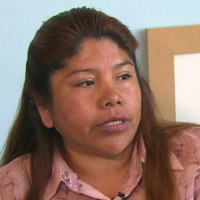
Muthu
There are an estimated almost 8 million people living in modern slavery in India (GSI 2018). India has a population of more than 1.3 billion people, there are still at least 270 million people living on less than US$1.90 per day. While laws, systems and attitudes regarding key 'fault lines' such as the caste system, gender and feudalism are rapidly changing, social change of this depth and scale necessarily takes time. In this context, it is perhaps unsurprising that existing research suggests that all forms of modern slavery continue to exist in India, including intergenerational bonded labour, forced child labour, commercial sexual exploitation, forced begging, forced recruitment into nonstate armed groups and forced marriage. Muthu was promised Rs 600 per month as well as another Rs 30,000 at the end of her three-year contract. She was not paid a penny after being fired just before the end of her contract.

Mahadevi
There are an estimated almost 8 million people living in modern slavery in India (GSI 2018). India has a population of more than 1.3 billion people, there are still at least 270 million people living on less than US$1.90 per day. While laws, systems and attitudes regarding key 'fault lines' such as the caste system, gender and feudalism are rapidly changing, social change of this depth and scale necessarily takes time. In this context, it is perhaps unsurprising that existing research suggests that all forms of modern slavery continue to exist in India, including intergenerational bonded labour, forced child labour, commercial sexual exploitation, forced begging, forced recruitment into nonstate armed groups and forced marriage. Mahadevi was forced to work long hours in a garment factory, with no pay for overtime and no breaks. She tells of the poor living conditions she was forced to stay in.

Selvi
There are an estimated almost 8 million people living in modern slavery in India (GSI 2018). India has a population of more than 1.3 billion people, there are still at least 270 million people living on less than US$1.90 per day. While laws, systems and attitudes regarding key 'fault lines' such as the caste system, gender and feudalism are rapidly changing, social change of this depth and scale necessarily takes time. In this context, it is perhaps unsurprising that existing research suggests that all forms of modern slavery continue to exist in India, including intergenerational bonded labour, forced child labour, commercial sexual exploitation, forced begging, forced recruitment into nonstate armed groups and forced marriage. Selvi worked in a mill in Palladam and was not paid for her 18 months’ work. After she had to leave the mill due to ill-health she recollected her experience.

Kahlid
There are an estimated almost 8 million people living in modern slavery in India (GSI 2018). India has a population of more than 1.3 billion people, there are still at least 270 million people living on less than US$1.90 per day. While laws, systems and attitudes regarding key 'fault lines' such as the caste system, gender and feudalism are rapidly changing, social change of this depth and scale necessarily takes time. In this context, it is perhaps unsurprising that existing research suggests that all forms of modern slavery continue to exist in India, including intergenerational bonded labour, forced child labour, commercial sexual exploitation, forced begging, forced recruitment into nonstate armed groups and forced marriage. Kahlid, a 36 year old garment worker tells of how he is forced to work long hours for little pay in poor living conditions. He talks of the health problems he and other workers face in the garment factory.

Suresh
There are an estimated almost 8 million people living in modern slavery in India (GSI 2018). India has a population of more than 1.3 billion people, there are still at least 270 million people living on less than US$1.90 per day. While laws, systems and attitudes regarding key 'fault lines' such as the caste system, gender and feudalism are rapidly changing, social change of this depth and scale necessarily takes time. In this context, it is perhaps unsurprising that existing research suggests that all forms of modern slavery continue to exist in India, including intergenerational bonded labour, forced child labour, commercial sexual exploitation, forced begging, forced recruitment into nonstate armed groups and forced marriage. Suresh is 14 years old and describes a lack of legal agreement with her employer leaves her vulnerable to labour exploitation.

Shahid
There are an estimated almost 8 million people living in modern slavery in India (GSI 2018). India has a population of more than 1.3 billion people, there are still at least 270 million people living on less than US$1.90 per day. While laws, systems and attitudes regarding key 'fault lines' such as the caste system, gender and feudalism are rapidly changing, social change of this depth and scale necessarily takes time. In this context, it is perhaps unsurprising that existing research suggests that all forms of modern slavery continue to exist in India, including intergenerational bonded labour, forced child labour, commercial sexual exploitation, forced begging, forced recruitment into nonstate armed groups and forced marriage. At 15 years old Shahid was forced to work in a garment factory after his father borrowed money to pay for health care. He is forced to work long hours for little pay, what he does earn goes to pay off his father’s debt.

Nanhe
There are an estimated almost 8 million people living in modern slavery in India (GSI 2018). India has a population of more than 1.3 billion people, there are still at least 270 million people living on less than US$1.90 per day. While laws, systems and attitudes regarding key 'fault lines' such as the caste system, gender and feudalism are rapidly changing, social change of this depth and scale necessarily takes time. In this context, it is perhaps unsurprising that existing research suggests that all forms of modern slavery continue to exist in India, including intergenerational bonded labour, forced child labour, commercial sexual exploitation, forced begging, forced recruitment into nonstate armed groups and forced marriage.Nanhe was a teenager when he began working in a garment factory in Delhi to pay of his father’s debts. Nanhe is forced to stay in the factory for days at a time and tells of the health problems he and others suffer from working there.

Hasnain
There are an estimated almost 8 million people living in modern slavery in India (GSI 2018). India has a population of more than 1.3 billion people, there are still at least 270 million people living on less than US$1.90 per day. While laws, systems and attitudes regarding key 'fault lines' such as the caste system, gender and feudalism are rapidly changing, social change of this depth and scale necessarily takes time. In this context, it is perhaps unsurprising that existing research suggests that all forms of modern slavery continue to exist in India, including intergenerational bonded labour, forced child labour, commercial sexual exploitation, forced begging, forced recruitment into nonstate armed groups and forced marriage.Hasnain, a 15 year-old garment worker tells of how factory owners in India bribe police to prevent raids on places using child labour. Hasnain is forced to work long hours for little pay in order to help provide for his family.

Annis
There are an estimated almost 8 million people living in modern slavery in India (GSI 2018). India has a population of more than 1.3 billion people, there are still at least 270 million people living on less than US$1.90 per day. While laws, systems and attitudes regarding key 'fault lines' such as the caste system, gender and feudalism are rapidly changing, social change of this depth and scale necessarily takes time. In this context, it is perhaps unsurprising that existing research suggests that all forms of modern slavery continue to exist in India, including intergenerational bonded labour, forced child labour, commercial sexual exploitation, forced begging, forced recruitment into nonstate armed groups and forced marriage.Annis was forced to go out to work after his father became sick and blind. He is forced to work long hours in a garment factory for little pay. Whatever he does earn, Annis sends back to his family. He tells of how he is forced to sleep where he works, live in unhygienic conditions and has his pay cut whenever he makes a mistake.

Gunja
The Global Slavery Index 2018 estimates that on any given day there were nearly 8 million people living in modern slavery in India. While the bonded labour system is formally abolished and criminalised, recent research indicated that bonded labour is still prevalent in India. A 2016 report found that in the state of Tamil Nadu, 351 of 743 spinning mills used bonded labour schemes, otherwise known as Sumangali schemes. Similarly in granite quarries, wage advances and loans with an interest ranging from 24% to 36% are used to bond workers. Situations of debt bondage are often aggravated by the need to raise emergency funds or take on loans for health crises. Gunja moved to Delhi from Tripura in the hopes of finding work. However, unable to make enough money to support his family, was forced to take out a loan from the garment factory owner where he worked. He is now trapped in debt bondage until he has paid back the money he borrowed.

Flor (Narrative 1)
In 2001, Flor Molina was 28 years old and had just lost her youngest child. She was working two jobs in Puebla, Mexico, but not making enough money to feed and clothe her surviving children. At night, she took sewing classes. When her sewing teacher told her about a job in the United States, she accepted. But a woman confiscated her documents at the border. She was taken to Los Angeles, and immediately put to work in a sewing factory. There she worked 18-hour-days, was subjected to physical abuse, and wasn’t allowed to leave the building unattended. She escaped after 40 days and was helped by CAST, an LA-based NGO. She told her story in 2010, as part of the California legislature's hearings on the California’s Transparency in Supply Chains Act. The law requires companies doing business in California with more than $100 million in annual global profits to report their efforts to eliminate slavery from their supply chains. Flor is now a member of CAST’s Survivors Caucus, a group of women from numerous countries who escaped forced labor in the United States. Another narrative by Flor can be found in the archive.